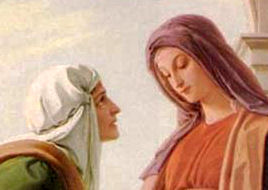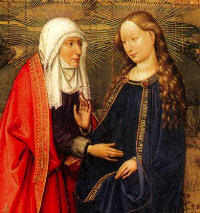Feast of the Visitation of the Blessed Virgin Mary
The feast of the Visitation recalls to us the following great truths and events: The visit of the Blessed Virgin Mary to her cousin Elizabeth shortly after the Annunciation; the cleansing of John the Baptist from original sin in the womb of his mother at the words of Our Lady's greeting; Elizabeth's proclaiming of Mary—under the inspiration of the Holy Ghost—as Mother of God and "blessed among women"; Mary's singing of the sublime hymn, Magnificat ("My soul doth magnify the Lord") which has become a part of the daily official prayer of the Church. The Visitation is frequently depicted in art, and was the central mystery of St. Francis de Sales' devotions.
The Mass of today salutes her who in her womb bore the King of heaven and earth, the Creator of the world, the Son of the Eternal Father, the Sun of Justice. It narrates the cleansing of John from original sin in his mother's womb. Hearing herself addressed by the most lofty title of "Mother of the Lord" and realizing what grace her visit had conferred on John, Mary broke out in that sublime canticle of praise proclaiming prophetically that henceforth she would be venerated down through the centuries:
"My soul doth magnify the Lord, and my spirit hath rejoiced in God my Savior. Because he that is mighty, hath done great things to me, and holy is His name" (Lk. 1:46).
—Excerpted from the Cathedral Daily Missal
This feast is of medieval origin, it was kept by the Franciscan Order before 1263, and soon its observance spread throughout the entire Church. Previously it was celebrated on July 2. Now it is celebrated between the solemnity of the Annunciation of the Lord and the birth of St. John the Baptist, in conformity with the Gospel accounts. Some places appropriately observe a celebration of the reality and sanctity of human life in the womb. The liturgical color is white.
The Visitation
And Mary rising up in those days went into the hill country with haste, into a city of Juda. [Lk. 1:39]
How lyrical that is, the opening sentence of St. Luke's description of the Visitation. We can feel the rush of warmth and kindness, the sudden urgency of love that sent that girl hurrying over the hills. "Those days" in which she rose on that impulse were the days in which Christ was being formed in her, the impulse was his impulse.
Many women, if they were expecting a child, would refuse to hurry over the hills on a visit of pure kindness. They would say they had a duty to themselves and to their unborn child which came before anything or anyone else.
 The Mother of God considered no such thing. Elizabeth was going to have a child, too, and although Mary's own child was God, she could not forget Elizabeth's need—almost incredible to us, but characteristic of her.
The Mother of God considered no such thing. Elizabeth was going to have a child, too, and although Mary's own child was God, she could not forget Elizabeth's need—almost incredible to us, but characteristic of her.
She greeted her cousin Elizabeth, and at the sound of her voice, John quickened in his mother's womb and leapt for joy.
I am come, said Christ, that they may have life and may have it more abundantly. [Jn. 10, 10] Even before He was born His presence gave life.
With what piercing shoots of joy does this story of Christ unfold! First the conception of a child in a child's heart, and then this first salutation, an infant leaping for joy in his mother's womb, knowing the hidden Christ and leaping into life.
How did Elizabeth herself know what had happened to Our Lady? What made her realize that this little cousin who was so familiar to her was the mother of her God?
She knew it by the child within herself, by the quickening into life which was a leap of joy.
If we practice this contemplation taught and shown to us by Our Lady, we will find that our experience is like hers.
If Christ is growing in us, if we are at peace, recollected, because we know that however insignificant our life seems to be, from it He is forming Himself; if we go with eager wills, "in haste," to wherever our circumstances compel us, because we believe that He desires to be in that place, we shall find that we are driven more and more to act on the impulse of His love.
And the answer we shall get from others to those impulses will be an awakening into life, or the leap into joy of the already wakened life within them.
Excerpted from The Reed of God, Caryll Houselander
Patronage: St. Elizabeth: Expectant mothers.
Symbols: St. Elizabeth or Elisabeth: Pregnant woman saluting the Virgin; Elderly woman holding St. John Baptist; huge rock with a doorway in it; in company with St. Zachary.
St. Zacharias or Zachary: Priest's robes; thurible; altar; angel; lighted taper; Phyrgian helmet.
Things to Do:
- Read Luke 1:39-47, the story of the Visitation. Read and meditate on the words of the Magnificat and the Hail Mary, two prayers from this feast. For those with children, depending on the ages, assign memorization for these prayers. Also discuss the meaning of the text as a family.
- This feast reminds us to be charitable to our neighbors. Try to assist some mother (expectant or otherwise), visit the elderly or sick, make a dinner for someone, etc.

No comments:
Post a Comment